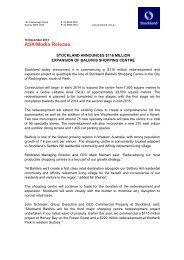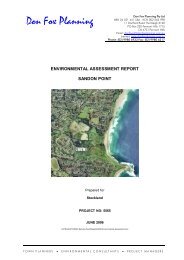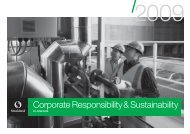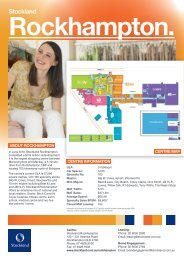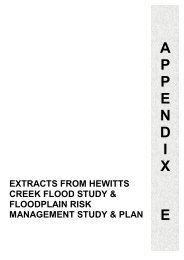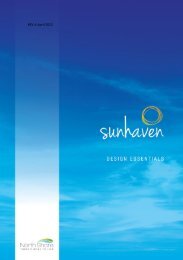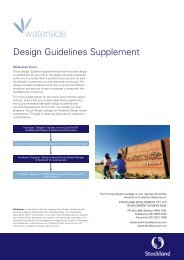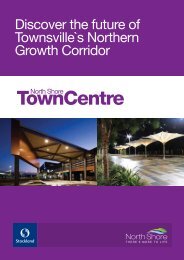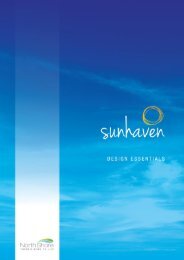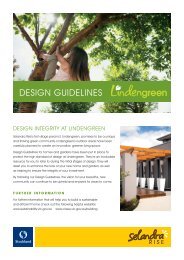Download PDF - Stockland
Download PDF - Stockland
Download PDF - Stockland
Create successful ePaper yourself
Turn your PDF publications into a flip-book with our unique Google optimized e-Paper software.
CASE STUDY<br />
Retirement Living solar panels<br />
Monitor: Streamline our reporting<br />
and monitor emissions and<br />
energy targets<br />
We have continued to improve how we<br />
set and monitor energy efficiency and<br />
emissions targets for our businesses<br />
through our carbon abatement cost<br />
curve work and its integration into our<br />
online CCAP tool. This has helped us<br />
to understand and better communicate<br />
the most cost effective actions to reduce<br />
emissions across our portfolio. In FY09<br />
we used our CCAP tool to establish<br />
evidence-based targets. In FY10 we<br />
undertook further evidence-based<br />
modelling, splitting out the cost and<br />
benefits of energy efficiency for both us<br />
and our tenants and demonstrating the<br />
very real problem of ‘split incentives’*.<br />
We have commenced the transfer of<br />
responsibility for greenhouse gas data<br />
collection from our sustainability teams to<br />
our group and business unit finance teams,<br />
further embedding carbon and energy<br />
reporting as a standard business practice.<br />
Reduce: Reduce emissions<br />
where we have both direct control,<br />
and scope to influence<br />
Energy efficiency is the most cost-effective<br />
way for our organisation to reduce<br />
emissions. Our emission intensity results<br />
for FY10 were mixed. Our office portfolio<br />
reduced emissions intensity by 7 per cent<br />
and our retail portfolio increased emissions<br />
intensity by 2 per cent. These results are<br />
discussed in our energy efficiency section.<br />
We will continue to invest in energy<br />
efficiency across our organisation.<br />
Minimum development and operation<br />
standards have been put in place by each<br />
of our business units to ensure a consistent<br />
approach to emissions reduction.<br />
Gowanbrae, Vic<br />
In 2009 the Federal Government introduced<br />
an initiative to provide funding for solar<br />
panels in private dwellings. To help<br />
residents in our Retirement Living villages<br />
access this funding we:<br />
• Developed a communications plan,<br />
• Held a roadshow to introduce the<br />
program and the nominated providers,<br />
• Nominated a <strong>Stockland</strong> Project Manager,<br />
• Provided a contact point for feedback<br />
on individual issues,<br />
• Established a schedule for the roll out<br />
of the program,<br />
• Put in place a quality assurance program.<br />
Village roadshow sessions were held<br />
across the portfolio to provide residents<br />
with information on the application process.<br />
The selected contractors were vetted to<br />
ensure they met our standards and the<br />
requirements of the program. This approach<br />
ensured that we leveraged the scale of the<br />
solar panels project so that all works could<br />
be completed within the funding available,<br />
resulting in a project which was cost neutral<br />
for our residents.<br />
Regular status reports were compiled by<br />
of our Project Manager and circulated<br />
to the village associations. Residents’<br />
concerns included the impact of the panels<br />
on the streetscape and the timing of the<br />
required access to the individual units. At<br />
the completion of each village a review of<br />
the works was undertaken by our Project<br />
Manager. Any remedial works required<br />
to ensure compliance with standards,<br />
or repairs to the building, were completed<br />
at the cost of the contractor prior to<br />
payment being made from the Federal<br />
Government scheme.<br />
Benefits of the program<br />
While the direct results from this program<br />
are measured in the numbers of units<br />
to which solar panels were installed<br />
(approximately 2,400 upon program<br />
completion) the short and long-term<br />
benefits have been significant and varied.<br />
These include:<br />
• 70 per cent of our independent<br />
living unit portfolio was fitted<br />
with a solar panel at no cost<br />
to the resident,<br />
• Reduced greenhouse gas emissions<br />
for our villages,<br />
• Reduced power utility costs for our<br />
residents of approximately 20 per cent,<br />
• Potentially enhanced property values.<br />
As with any major undertaking that involves<br />
a wide range of stakeholder groups,<br />
the importance of clear and frequent<br />
communication was crucial to the project’s<br />
success. In this particular project the key<br />
lessons learned were that our residents<br />
require respectful, frequent and simple<br />
communication to overcome resistance<br />
to change and that they are sympathetic to<br />
initiatives that reduce environmental impacts.<br />
* Split incentives occur where the costs and benefits of<br />
energy efficiency and emissions reductions accrue to<br />
different parties. In the case of property, this typically<br />
occurs where the building owner invests in energy<br />
efficiency programs, however the benefits of reduced<br />
energy costs may be largely realised by the tenant.<br />
<strong>Stockland</strong> Corporate Responsibility & Sustainability Report June 2010<br />
75



